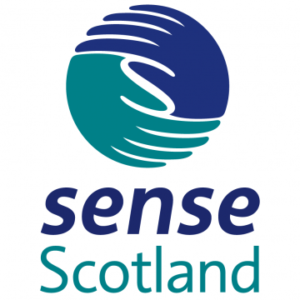Sense Scotland – Communication Approaches and Systems
Recently at Sense Scotland, we have been updating information on the communication approaches and systems that we regularly use. This has reminded us of two main ideas: 1) the human need to connect with others to share stories, information and our life experiences is incredibly powerful; and 2) humans are incredibly diverse in their efforts to make contact with other people.
On a day-to-day basis, in Sense Scotland we use more than 25 different communication systems. Amongst this, there are at least 10 different signed communication and language approaches, including British Sign Language (BSL), tactile forms of BSL used by people who are deafblind and Sign Supported English (BSL signs are used but in the word order of spoken English as opposed to BSL’s own grammatical rules). Other sign-supported systems such as Makaton and Signalong were originally developed for learners who have communication support needs arising from learning disabilities. The Cannan-Barrie system was developed to support the learning of children and young people who were deafblind and incorporates tactile on-body signs that grow from the tactile-bodily perspective of someone born deafblind. There are people who use BSL finger-spelling, Deafblind Manual and even American Sign Language (ASL) finger-spelling.
Some schools will prefer one approach over another and sometimes the choice reflects the sensory and learning needs of individual children. There are similar choices made around tactile writing systems (e.g. Braille or Moon) and visual symbol systems (e.g. Widgit, Makaton, PCS, Bliss etc). These decisions affect people for their whole lives and likely will become their preferred language – which is why we have more than 25 systems in use every day. Some people use more than one approach. For example, spoken language and visual symbols; Makaton signs but PCS symbols; concrete objects of reference for some activities yet abstract for other activities. And people often use different systems to receive and express information. For example, you might listen to spoken information and respond using Makaton – or the other way around; you may use tactile BSL to receive information and visual BSL to express your thoughts; you could use a combination of photographs and Widgit symbols to understand your activity choices and then use your body language/movements to make the choice.
Sometimes two approaches might be combined. For example, you use BSL but you understand more if it is signed slowly, less signs are used, signs unique to you are added in, the other person signs at just the right distance, images are used to supplement some of the signs. We could think of this as Easy-Sign BSL, similar to Easy Read documents which still use written English but with straightforward vocabulary and sentence structure, supplementary pictures and easier to follow layouts.
Could we provide an Easy Read Braille version of a consultation document, or a Large Print Easy Read summary of a Self-Directed Support leaflet, or a Support Plan that incorporates three different symbol systems as well as photographs and written text? These are the challenges that Sense Scotland and many organisations face on a day-to-day basis. If a consultation document arrives, even in accessible formats, we may have to work for many weeks to prepare additional versions of documents unique to the particular needs of people we support. We have learned from creative BSL interpreters, who have followed people around a room, even lain down on the floor next to them, whilst amending the speed of signing and incorporating individual signs, so that people are genuinely included in meetings. If people wish to be involved in recruiting their staff teams, we have prepared job descriptions in multiple formats; practiced with people using voice output devices or MP3 recordings on phones and tablets so they were confident asking their question; prepared interview scoring sheets in various formats so everyone can input their feedback. We prepare minutes of meetings in audio, Braille, graphics, Easy Read, BSL so that everyone has a full record of decisions and outcomes.
It is not enough to provide one size fits all solutions and imagine that inclusive communication is done! But it is not easy tailoring your communication approaches to meet the communication support needs of everyone you meet in life. That’s the challenge, however, if we wish to include everyone in the decisions affecting their lives.
For further information on the examples highlighted here, please contact pic@sensescotland.org.uk or look up the resources on Scotland’s Inclusive Communication Hub: www.inclusivecommunication.scot

